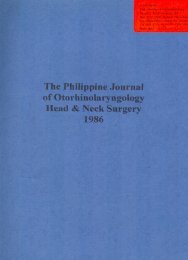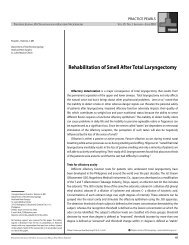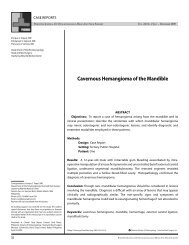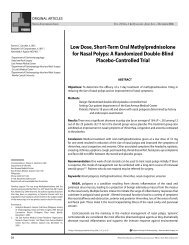You also want an ePaper? Increase the reach of your titles
YUMPU automatically turns print PDFs into web optimized ePapers that Google loves.
mechanical cause is considered, when some factors out. Nevertheless patient is still consistent with<br />
interfere with the flee patient movement of muscle, maxillary sinusitis.<br />
A force duction test was done on this patient and the<br />
results was negative, hence this has been ruled out. Tooth extraction was done together with our<br />
A myogenic cause results when a disease entity directly medical management of the sinusitis consisting of<br />
affects gravis. Historical and clinical investigations antibiotics, mucolytics, decongestants, and steroids.<br />
done does not indicate the presence of this disease. The nasal discharge gradually disappered, haziness or<br />
x-ray resolved and diplopia improved. This would<br />
Neurogenic etiology is lastly considered. This point to the maxillary sinusitis causing inflammation<br />
could either be congenital or acquired. Congenital of the nerve supplying the extraocular muscle and<br />
neurogenic cause is ruled out since the disease process resulting into ophthalmoplegia causing diplopia.<br />
started just two weeks prior to consultation. Under According to W. Jarred Goodwin, Jr. in 1975, "orbital<br />
the acquired classification, there are four (4) possi- infections is a threat to both vision and life and is<br />
bilities (1) trauma, which the patient denies, (2) vascular caused by paranasal infections in seventy five (75%)<br />
and/or metabolic disorders. Laboratory work-ups for percent patients". This is commonly periorbital<br />
hypertension and diabetes were done and all results cellulitis resulting from ethmoidal sinusitis. In our<br />
were negative, (3) aneurysm or space occupying patient the problem could have started from the dental<br />
lesions, in the presence of only an extraocular muscle caries affecting the maxillary sinus. On x-ray, no<br />
paralysis and in the absence of other neurologic findings haziness was noted on the ethmoid sinus and clinical<br />
this cannot be considered as an etiologic factor. Hence, investigation was done and other possible cause of<br />
the first three (3) causes have been ruled out. The the inflammation into which ophthalmoplegia can be<br />
fourth (4th) cause is the one considered in our patient, attributed were noted, hence everything points to a<br />
inflammation. Any infection in the area which may maxillary sinus problem.<br />
spread can cause inflammation of the nerve itself.<br />
Review of the different literatures revealed that<br />
Basing on the history of a two (2) week duration there has been no known report of maxillary sinusitis<br />
of nasal stufiness, whitish to yellowish nasal and causing ophthalmoplegia. This could may well be the<br />
postnasal discharge, headache and low grade fever;, first known report. Considering the comment of<br />
physical findings of discharge on anterior and pos- Goodwin, we began to think of the possible pathway<br />
terior rhinoscopy, dental caries on the first (lst) and for maxillary sinusitis to cause ophthalmoplegia Kelvin,<br />
second (2nd) upper molars, right maxillary tender- et al in a related study of one hundred twenty (120)<br />
hess, the patient has been diagnosed to have Acute case of optic neuritis showed twenty six (26) cases<br />
maxillary sinusitis, right, x-ray studies showed haziness to be second try to sphenoethmoiditis and two (2)<br />
of the maxillary sinus consistent with sinusitis, were associated with maxillary sinusitis.<br />
Result of the culture and sensitivity study of the In a textbook by Mackay and Bull, it was noted<br />
maxillary aspirate is negative. Pekka, Karma M.D. et that the orbital floor, which is the roof of the maxillary<br />
al in an article entitled "Bacteria in maxillary sinusi- sinus is incomplete at its central portion and is travtis",<br />
noted that forty six (46) percent of sinus secre- ersed by a grove known as the infraorbital fissure.<br />
tions didn't grow any bacteria. Similar/unpublished This fissure does not only house the infraorbital nerve<br />
studies by one of the authors showed eighty (80) but also the inferior ophthalmic vein with the tribupercent<br />
to grow no organisms, taries to the superior ophthalmic vein. These veins<br />
are included in the extensive system of valveless veins<br />
Antibiotics taken prior to obtaining of the speci- between the nose, paranasal sinuses, orbit and cavmen<br />
and also the involvement of a festidious anaero- ernous sinus which are considered as one of the<br />
bic organism could also play a role. In a study done preformed pathways for an infection to penetrate the<br />
by Frederick and Brandenique, it states that the mucosal adjacent orbit.<br />
culture described twenty-five (25) anaerobic bacterial<br />
strains in seventeen (17) sinuses (28%), but they never There is also a clear cut connection between the<br />
grew heavily. Possibility and/or probability of the inferior orbital fissure and the superior orbital fissure<br />
involvement of a viral organism cannot also be ruled which contains the nerve supply to the extraocular-
















